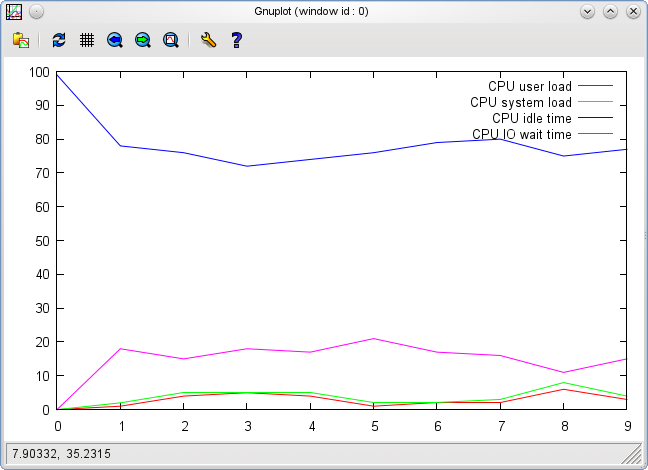

- #Gnuplot from file how to
- #Gnuplot from file full
- #Gnuplot from file download
- #Gnuplot from file free
# Instead of loading variables into a vector and multiplying # VECTORS, PLOTTING DATA FROM A FILE, PLOTTING SINGLE POINTS # The linestyle command is a shortcut to changing the points and line types each time # STORING AND USING A LINE TYPE AND POINT TYPE Set arrow from 1,2 to 4,8.4 nohead lt -1 lw 1.2 # use the arrow command with nohead to draw just a line: # DRAW A LINE OR ARROW BETWEEN TWO POINTS # lw chooses a line width 1=normal, can use 0.8, 0.3, 1.5, 3, etc. # for postscipt -1=normal, 1=grey, 2=dashed, 3=hashed, 4=dot, 5=dot-dash # lt must be specified before pt for colored points # lt chooses a particular line type: -1=black 1=red 2=grn 3=blue 4=purple 5=aqua 6=brn 7=orange 8=light-brn # type 'test' to see the colors and point types available. # 7=filled circle, 8=triangle, 9=filled triangle, etc. # pt gives a particular point type: 1=diamond 2=+ 3=square 4=X 5=triangle 6=* # lt is for color of the points: -1=black 1=red 2=grn 3=blue 4=purple 5=aqua 6=brn 7=orange 8=light-brn # type 'test' to see the colors and point types available # for errorbar options type 'help plot errorbars' # choice of points, lines, linespoints, steps, boxes, errorbars, impulses, etc. # the noautoscale, xrange, yrange change the x- and y-limits # eps file each time I load, and then a third window running ghostview to view the eps file. # window running gnuplot where I simply keep loading in the new command file and it makes a new I edit the command file in one window, have a second Along the learning curve, I made some notes for myself. I use now on my linux machines to make publication quality scientific
#Gnuplot from file free
In this case, gnuplot works really well.Gnuplot is a free program that plots 2D and 3D data. We have a 2.3GB file of XY points where we want to plot only a couple columns.
#Gnuplot from file how to
How to turn off the dataset legend that takes up so much room in the plot area Setting line color: You need this when GNUPLOT uses yellow as it is hard to see Plot "Processed_P1-Data.csv" using 2:3 with lines If you want lines instead of only data points use: In order to plot multiple lines in a single plot, simply put them in a single plot command like If you want more than one plot on the same graph Set format x '10^' #<- enhanced text.Īt this point the plot function should probably start working If you use a log scale you will probably also want to format the log axis value labeling. 00010 etc and what you want is shown below. Plotting Log(X) axis values correctly Without this statement your X axis is labeled: 00000 00000 00000. Or whatever you like for the first value just make it >0. If you have not already done so set your X range so it does not include zero with: set xrange X range must be greater than 0 for log scale When you try to plot a Log(X) axis you will see the following error Setting the range to avoid taking log(0) and getting an error Plot "Current-Voltage-Power.csv" using 1:3 with line lt-1 lw 3,"Current-Voltage-Power.csv" using 1:7 with line lt-1 lw 3 axes x1y2,"Current-Voltage-Power.csv" using 1:6 with line lt-1 lw 3

Set format y "%4.0s" – this gives 4 integer with nothing after the decimal point Set mxtics 2 # this divides the interval between major tics by 2 and thus you get 1 tic in between major tics This will automatically generate tic marks every 0.5 along x, but will also add an explicit labeled tic mark at pi It appears they do not have an explicit command for "linear" mode. When you need to switch back out of this mode: Use the following command to select a log scale on X: You need a right handed karate chopped n & r. This will drive you crazy because it looks just fine when you look at the file with a text editor unless you are using something like NotePad++. Watch out for excel files that export sometimes with only a CR and no LF character. This needs to match the field separator in your file. Set up GnuPlot to recognize comma as the field separator The button with the folder icon and ChDir is what you want:
#Gnuplot from file full
Point Gnuplot to the correct directory to find the file full of data that you want to plot
#Gnuplot from file download
You can download the file used in the example below and follow along: Processed_P1-Data.csv



 0 kommentar(er)
0 kommentar(er)
